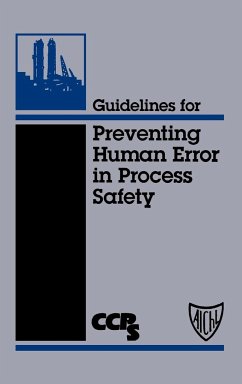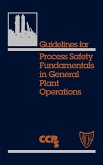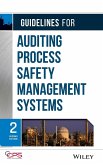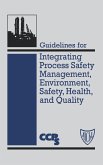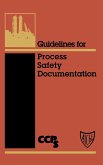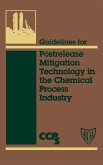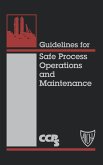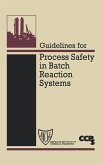Center for Chemical Process Safety (CCPS)
Guidelines for Preventing Human Error in Process Safety
Center for Chemical Process Safety (CCPS)
Guidelines for Preventing Human Error in Process Safety
- Gebundenes Buch
- Merkliste
- Auf die Merkliste
- Bewerten Bewerten
- Teilen
- Produkt teilen
- Produkterinnerung
- Produkterinnerung
Almost all the major accident investigations--Texas City, Piper Alpha, the Phillips 66 explosion, Feyzin, Mexico City--show human error as the principal cause, either in design, operations, maintenance, or the management of safety. This book provides practical advice that can substantially reduce human error at all levels. In eight chapters--packed with case studies and examples of simple and advanced techniques for new and existing systems--the book challenges the assumption that human error is "unavoidable." Instead, it suggests a systems perspective. This view sees error as a consequence of…mehr
Andere Kunden interessierten sich auch für
![Guidelines for Process Safety Fundamentals in General Plant Operations Guidelines for Process Safety Fundamentals in General Plant Operations]() Center for Chemical Process Safety (CCPS)Guidelines for Process Safety Fundamentals in General Plant Operations107,99 €
Center for Chemical Process Safety (CCPS)Guidelines for Process Safety Fundamentals in General Plant Operations107,99 €![Guidelines for Auditing Process Safety Management Systems Guidelines for Auditing Process Safety Management Systems]() Center for Chemical Process Safety (CCPS)Guidelines for Auditing Process Safety Management Systems206,99 €
Center for Chemical Process Safety (CCPS)Guidelines for Auditing Process Safety Management Systems206,99 €![Guidelines for Integrating Process Safety Management, Environment, Safety, Health, and Quality Guidelines for Integrating Process Safety Management, Environment, Safety, Health, and Quality]() Center for Chemical Process Safety (CCPS)Guidelines for Integrating Process Safety Management, Environment, Safety, Health, and Quality201,99 €
Center for Chemical Process Safety (CCPS)Guidelines for Integrating Process Safety Management, Environment, Safety, Health, and Quality201,99 €![Guidelines for Process Safety Documentation Guidelines for Process Safety Documentation]() Center for Chemical Process Safety (CCPS)Guidelines for Process Safety Documentation186,99 €
Center for Chemical Process Safety (CCPS)Guidelines for Process Safety Documentation186,99 €![Guidelines for Postrelease Mitigation Technology in the Chemical Process Industry Guidelines for Postrelease Mitigation Technology in the Chemical Process Industry]() Center for Chemical Process Safety (CCPS)Guidelines for Postrelease Mitigation Technology in the Chemical Process Industry156,99 €
Center for Chemical Process Safety (CCPS)Guidelines for Postrelease Mitigation Technology in the Chemical Process Industry156,99 €![Guidelines for Safe Process Operations and Maintenance Guidelines for Safe Process Operations and Maintenance]() Center for Chemical Process Safety (CCPS)Guidelines for Safe Process Operations and Maintenance156,99 €
Center for Chemical Process Safety (CCPS)Guidelines for Safe Process Operations and Maintenance156,99 €![Guidelines for Process Safety in Batch Reaction Systems Guidelines for Process Safety in Batch Reaction Systems]() Center for Chemical Process Safety (CCPS)Guidelines for Process Safety in Batch Reaction Systems191,99 €
Center for Chemical Process Safety (CCPS)Guidelines for Process Safety in Batch Reaction Systems191,99 €-
-
-
Almost all the major accident investigations--Texas City, Piper Alpha, the Phillips 66 explosion, Feyzin, Mexico City--show human error as the principal cause, either in design, operations, maintenance, or the management of safety. This book provides practical advice that can substantially reduce human error at all levels. In eight chapters--packed with case studies and examples of simple and advanced techniques for new and existing systems--the book challenges the assumption that human error is "unavoidable." Instead, it suggests a systems perspective. This view sees error as a consequence of a mismatch between human capabilities and demands and inappropriate organizational culture. This makes error a manageable factor and, therefore, avoidable.
Hinweis: Dieser Artikel kann nur an eine deutsche Lieferadresse ausgeliefert werden.
Hinweis: Dieser Artikel kann nur an eine deutsche Lieferadresse ausgeliefert werden.
Produktdetails
- Produktdetails
- Verlag: Wiley
- Seitenzahl: 416
- Erscheinungstermin: 15. August 2004
- Englisch
- Abmessung: 235mm x 157mm x 29mm
- Gewicht: 825g
- ISBN-13: 9780816904617
- ISBN-10: 0816904618
- Artikelnr.: 23582627
- Verlag: Wiley
- Seitenzahl: 416
- Erscheinungstermin: 15. August 2004
- Englisch
- Abmessung: 235mm x 157mm x 29mm
- Gewicht: 825g
- ISBN-13: 9780816904617
- ISBN-10: 0816904618
- Artikelnr.: 23582627
The CENTER FOR CHEMICAL PROCESS SAFETY (CCPS), an industry technology alliance of the American Institute of Chemical Engineers (AIChE), has been a world leader in developing and disseminatinginformation on process safety management and technology since 1985. CCPS has published over 80 books in its process safety guidelines and process safety concepts series. For more information, visit www.ccpsonline.org.
List of Figures and Tables.
Preface.
Glossary and Acronyms.
1. Introduction: The Role of Human Error in Chemical Process Safety.
1.1 Introduction.
1.2 The Role of Human Error in System Accidents.
1.3 Why Is Human Error Neglected in the CPI?
1.4 Benefits of Improved Human Performance.
1.5 The Traditional and System-induced Error Approach.
1.6 A Demand-Resource Mismatch View of Error.
1.7 A Case Study Illustrating the System-Induced Error Approach.
1.8 From Theory to Practice.
1.9 Appendix Case Studies.
2. Understanding Human Performance and Error.
2.1 Purpose of the Chapter.
2.2 Concepts of Human Error.
2.3 An Overview of the Four Perspective on Human Error.
2.4 The Traditional Safety Engineering Approach to Accidents and Human
Error.
2.5 The Human Factors Engineering and Ergonomics Approach (HF/E).
2.6 The Cognitive Engineering Perspective.
2.7 The Sociotechnical Perspective.
2.8 Summary.
2.9 Appendix 2A. Process Plant Example of the Stepladder Model.
2.10 Appendix 2B. Flowcharts for Using the Rasmussen Sequential Model for
Incident Analysis (Petersen, 1985).
2.11 Appendix 2C. Case Study Illustrating the Use of the Sequential Model.
3. Factors Affecting Human Performance in the Chemical Industry.
3.1 Introduction.
3.2 Applications of Performance-Influencing Factors.
3.3 A Classification Structure for Performance-Influencing Factors.
3.4 Operating Environment.
3.5 Task Characteristics.
3.6 Operator Characteristics.
3.7 Organizational and Social Factors.
3.8 Interaction of Performance-Influencing Factors.
3.9 Variability of Human Performance during Normal and Emergency
Situations.
3.10 Summary.
4. Analytical Methods for Predicting and Reducing Human Error.
4.1 Introduction.
4.2 Data Acquisition Techniques.
4.3 Task Analysis.
4.4 Human Error Analysis Techniques.
4.5 Ergonomics Checklists.
4.6 Summary.
5. Qualitative and Quantitative Prediction of Human Error in Risk
Assessment.
5.1 Introduction.
5.2 The Role of Human Reliability in Risk Assessment.
5.3 System for Predictive Error Analysis and Reduction (SPEAR).
5.4 Critical Task Identification and Screening Analysis.
5.5 Qualitative Human Error Analysis.
5.6 Representation.
5.7 Quantification.
5.8 Summary.
5.9 Appendix 5A. Influence Diagram Calculations.
6. Data Collection and Incident Analysis Methods.
6.1 Introduction.
6.2 An Overview of Data Collection Systems.
6.3 Types of Data Collection Systems.
6.4 Organizational and Cultural Aspects of Data Collection.
6.5 Types of Data Collected.
6.6 Methods of Data Collection, Storage, and Retrieval.
6.7 Data Interpretation.
6.8 Root Cause Analysis Techniques.
6.9 Implementing and Monitoring the Effectiveness of Error Reduction
Measures.
6.10 Setting Up a Data Collection System in a Chemical Plant.
6.11 Summary.
7. Case Studies.
7.1 Introduction.
7.2 Case Study 1: Incident Analysis of Hydrocarbon Leak from Pipe.
7.3 Case Study 2: Incident Investigation: Mischarging of Solvent in a Batch
Plant.
7.4 Case Study 3: Design of Standard Operating Procedures for Task in Case
Study 2.
7.5 Case Study 4: Design of Visual Display Units for Computer-Controlled
Plant.
7.6 Case Study 5: Audit of Offshore Emergency Blowdown Operations.
8. Implementing an Integrated Error and Process Safety Management System at
the Plant.
8.1 Introduction.
8.2 Managing Human Error by Design.
8.3 Setting Up an Error Management System in an Existing Plant.
8.4 Summary.
References.
Bibliography.
Index.
Preface.
Glossary and Acronyms.
1. Introduction: The Role of Human Error in Chemical Process Safety.
1.1 Introduction.
1.2 The Role of Human Error in System Accidents.
1.3 Why Is Human Error Neglected in the CPI?
1.4 Benefits of Improved Human Performance.
1.5 The Traditional and System-induced Error Approach.
1.6 A Demand-Resource Mismatch View of Error.
1.7 A Case Study Illustrating the System-Induced Error Approach.
1.8 From Theory to Practice.
1.9 Appendix Case Studies.
2. Understanding Human Performance and Error.
2.1 Purpose of the Chapter.
2.2 Concepts of Human Error.
2.3 An Overview of the Four Perspective on Human Error.
2.4 The Traditional Safety Engineering Approach to Accidents and Human
Error.
2.5 The Human Factors Engineering and Ergonomics Approach (HF/E).
2.6 The Cognitive Engineering Perspective.
2.7 The Sociotechnical Perspective.
2.8 Summary.
2.9 Appendix 2A. Process Plant Example of the Stepladder Model.
2.10 Appendix 2B. Flowcharts for Using the Rasmussen Sequential Model for
Incident Analysis (Petersen, 1985).
2.11 Appendix 2C. Case Study Illustrating the Use of the Sequential Model.
3. Factors Affecting Human Performance in the Chemical Industry.
3.1 Introduction.
3.2 Applications of Performance-Influencing Factors.
3.3 A Classification Structure for Performance-Influencing Factors.
3.4 Operating Environment.
3.5 Task Characteristics.
3.6 Operator Characteristics.
3.7 Organizational and Social Factors.
3.8 Interaction of Performance-Influencing Factors.
3.9 Variability of Human Performance during Normal and Emergency
Situations.
3.10 Summary.
4. Analytical Methods for Predicting and Reducing Human Error.
4.1 Introduction.
4.2 Data Acquisition Techniques.
4.3 Task Analysis.
4.4 Human Error Analysis Techniques.
4.5 Ergonomics Checklists.
4.6 Summary.
5. Qualitative and Quantitative Prediction of Human Error in Risk
Assessment.
5.1 Introduction.
5.2 The Role of Human Reliability in Risk Assessment.
5.3 System for Predictive Error Analysis and Reduction (SPEAR).
5.4 Critical Task Identification and Screening Analysis.
5.5 Qualitative Human Error Analysis.
5.6 Representation.
5.7 Quantification.
5.8 Summary.
5.9 Appendix 5A. Influence Diagram Calculations.
6. Data Collection and Incident Analysis Methods.
6.1 Introduction.
6.2 An Overview of Data Collection Systems.
6.3 Types of Data Collection Systems.
6.4 Organizational and Cultural Aspects of Data Collection.
6.5 Types of Data Collected.
6.6 Methods of Data Collection, Storage, and Retrieval.
6.7 Data Interpretation.
6.8 Root Cause Analysis Techniques.
6.9 Implementing and Monitoring the Effectiveness of Error Reduction
Measures.
6.10 Setting Up a Data Collection System in a Chemical Plant.
6.11 Summary.
7. Case Studies.
7.1 Introduction.
7.2 Case Study 1: Incident Analysis of Hydrocarbon Leak from Pipe.
7.3 Case Study 2: Incident Investigation: Mischarging of Solvent in a Batch
Plant.
7.4 Case Study 3: Design of Standard Operating Procedures for Task in Case
Study 2.
7.5 Case Study 4: Design of Visual Display Units for Computer-Controlled
Plant.
7.6 Case Study 5: Audit of Offshore Emergency Blowdown Operations.
8. Implementing an Integrated Error and Process Safety Management System at
the Plant.
8.1 Introduction.
8.2 Managing Human Error by Design.
8.3 Setting Up an Error Management System in an Existing Plant.
8.4 Summary.
References.
Bibliography.
Index.
List of Figures and Tables.
Preface.
Glossary and Acronyms.
1. Introduction: The Role of Human Error in Chemical Process Safety.
1.1 Introduction.
1.2 The Role of Human Error in System Accidents.
1.3 Why Is Human Error Neglected in the CPI?
1.4 Benefits of Improved Human Performance.
1.5 The Traditional and System-induced Error Approach.
1.6 A Demand-Resource Mismatch View of Error.
1.7 A Case Study Illustrating the System-Induced Error Approach.
1.8 From Theory to Practice.
1.9 Appendix Case Studies.
2. Understanding Human Performance and Error.
2.1 Purpose of the Chapter.
2.2 Concepts of Human Error.
2.3 An Overview of the Four Perspective on Human Error.
2.4 The Traditional Safety Engineering Approach to Accidents and Human
Error.
2.5 The Human Factors Engineering and Ergonomics Approach (HF/E).
2.6 The Cognitive Engineering Perspective.
2.7 The Sociotechnical Perspective.
2.8 Summary.
2.9 Appendix 2A. Process Plant Example of the Stepladder Model.
2.10 Appendix 2B. Flowcharts for Using the Rasmussen Sequential Model for
Incident Analysis (Petersen, 1985).
2.11 Appendix 2C. Case Study Illustrating the Use of the Sequential Model.
3. Factors Affecting Human Performance in the Chemical Industry.
3.1 Introduction.
3.2 Applications of Performance-Influencing Factors.
3.3 A Classification Structure for Performance-Influencing Factors.
3.4 Operating Environment.
3.5 Task Characteristics.
3.6 Operator Characteristics.
3.7 Organizational and Social Factors.
3.8 Interaction of Performance-Influencing Factors.
3.9 Variability of Human Performance during Normal and Emergency
Situations.
3.10 Summary.
4. Analytical Methods for Predicting and Reducing Human Error.
4.1 Introduction.
4.2 Data Acquisition Techniques.
4.3 Task Analysis.
4.4 Human Error Analysis Techniques.
4.5 Ergonomics Checklists.
4.6 Summary.
5. Qualitative and Quantitative Prediction of Human Error in Risk
Assessment.
5.1 Introduction.
5.2 The Role of Human Reliability in Risk Assessment.
5.3 System for Predictive Error Analysis and Reduction (SPEAR).
5.4 Critical Task Identification and Screening Analysis.
5.5 Qualitative Human Error Analysis.
5.6 Representation.
5.7 Quantification.
5.8 Summary.
5.9 Appendix 5A. Influence Diagram Calculations.
6. Data Collection and Incident Analysis Methods.
6.1 Introduction.
6.2 An Overview of Data Collection Systems.
6.3 Types of Data Collection Systems.
6.4 Organizational and Cultural Aspects of Data Collection.
6.5 Types of Data Collected.
6.6 Methods of Data Collection, Storage, and Retrieval.
6.7 Data Interpretation.
6.8 Root Cause Analysis Techniques.
6.9 Implementing and Monitoring the Effectiveness of Error Reduction
Measures.
6.10 Setting Up a Data Collection System in a Chemical Plant.
6.11 Summary.
7. Case Studies.
7.1 Introduction.
7.2 Case Study 1: Incident Analysis of Hydrocarbon Leak from Pipe.
7.3 Case Study 2: Incident Investigation: Mischarging of Solvent in a Batch
Plant.
7.4 Case Study 3: Design of Standard Operating Procedures for Task in Case
Study 2.
7.5 Case Study 4: Design of Visual Display Units for Computer-Controlled
Plant.
7.6 Case Study 5: Audit of Offshore Emergency Blowdown Operations.
8. Implementing an Integrated Error and Process Safety Management System at
the Plant.
8.1 Introduction.
8.2 Managing Human Error by Design.
8.3 Setting Up an Error Management System in an Existing Plant.
8.4 Summary.
References.
Bibliography.
Index.
Preface.
Glossary and Acronyms.
1. Introduction: The Role of Human Error in Chemical Process Safety.
1.1 Introduction.
1.2 The Role of Human Error in System Accidents.
1.3 Why Is Human Error Neglected in the CPI?
1.4 Benefits of Improved Human Performance.
1.5 The Traditional and System-induced Error Approach.
1.6 A Demand-Resource Mismatch View of Error.
1.7 A Case Study Illustrating the System-Induced Error Approach.
1.8 From Theory to Practice.
1.9 Appendix Case Studies.
2. Understanding Human Performance and Error.
2.1 Purpose of the Chapter.
2.2 Concepts of Human Error.
2.3 An Overview of the Four Perspective on Human Error.
2.4 The Traditional Safety Engineering Approach to Accidents and Human
Error.
2.5 The Human Factors Engineering and Ergonomics Approach (HF/E).
2.6 The Cognitive Engineering Perspective.
2.7 The Sociotechnical Perspective.
2.8 Summary.
2.9 Appendix 2A. Process Plant Example of the Stepladder Model.
2.10 Appendix 2B. Flowcharts for Using the Rasmussen Sequential Model for
Incident Analysis (Petersen, 1985).
2.11 Appendix 2C. Case Study Illustrating the Use of the Sequential Model.
3. Factors Affecting Human Performance in the Chemical Industry.
3.1 Introduction.
3.2 Applications of Performance-Influencing Factors.
3.3 A Classification Structure for Performance-Influencing Factors.
3.4 Operating Environment.
3.5 Task Characteristics.
3.6 Operator Characteristics.
3.7 Organizational and Social Factors.
3.8 Interaction of Performance-Influencing Factors.
3.9 Variability of Human Performance during Normal and Emergency
Situations.
3.10 Summary.
4. Analytical Methods for Predicting and Reducing Human Error.
4.1 Introduction.
4.2 Data Acquisition Techniques.
4.3 Task Analysis.
4.4 Human Error Analysis Techniques.
4.5 Ergonomics Checklists.
4.6 Summary.
5. Qualitative and Quantitative Prediction of Human Error in Risk
Assessment.
5.1 Introduction.
5.2 The Role of Human Reliability in Risk Assessment.
5.3 System for Predictive Error Analysis and Reduction (SPEAR).
5.4 Critical Task Identification and Screening Analysis.
5.5 Qualitative Human Error Analysis.
5.6 Representation.
5.7 Quantification.
5.8 Summary.
5.9 Appendix 5A. Influence Diagram Calculations.
6. Data Collection and Incident Analysis Methods.
6.1 Introduction.
6.2 An Overview of Data Collection Systems.
6.3 Types of Data Collection Systems.
6.4 Organizational and Cultural Aspects of Data Collection.
6.5 Types of Data Collected.
6.6 Methods of Data Collection, Storage, and Retrieval.
6.7 Data Interpretation.
6.8 Root Cause Analysis Techniques.
6.9 Implementing and Monitoring the Effectiveness of Error Reduction
Measures.
6.10 Setting Up a Data Collection System in a Chemical Plant.
6.11 Summary.
7. Case Studies.
7.1 Introduction.
7.2 Case Study 1: Incident Analysis of Hydrocarbon Leak from Pipe.
7.3 Case Study 2: Incident Investigation: Mischarging of Solvent in a Batch
Plant.
7.4 Case Study 3: Design of Standard Operating Procedures for Task in Case
Study 2.
7.5 Case Study 4: Design of Visual Display Units for Computer-Controlled
Plant.
7.6 Case Study 5: Audit of Offshore Emergency Blowdown Operations.
8. Implementing an Integrated Error and Process Safety Management System at
the Plant.
8.1 Introduction.
8.2 Managing Human Error by Design.
8.3 Setting Up an Error Management System in an Existing Plant.
8.4 Summary.
References.
Bibliography.
Index.
